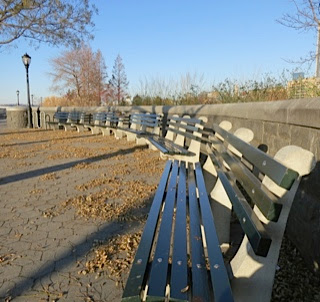My last six blog postings have been about
Hurricane Sandy - before, during and after. The "Before and During" were mainly about Drew and me, as our lives were
interrupted by a four-day loss of power. Last weekend, we experienced a world where lives were
halted by
a surge of water so powerful that it left many people with little, or nothing.
I wasn't expecting to do what we did in the Staten Island neighborhood of
Midland Beach. As volunteers from
Léman Manhattan Preparatory School, I thought we might drop off supplies, hand out water, sweep debris from sidewalks - important jobs, but nothing involving a mask, rubber gloves and an opportunity to walk in another's shoes. We gutted a home.

Walter stood beside his front door as our group, mingled with volunteers from other organizations, hauled load after load of the soggy, dripping, muddy remains of his house to the street. "I'm overwhelmed," he said. "I've been working four days, but you guys have done more in two hours than I did that whole time. Thank you."


I worked in the yard, with at least ten others, stuffing bags full of water-soaked baseball cards, balls, colored pens, a diary, teddy bear, books, shoes. . . clues to Walter and his wife, Margaret's, four children. . . all safe at a friend's house. Workers inside threw pots, pans, bathroom tile, shelving, sheetrock out windows, which we picked up and piled into more black bags.
After about an hour, I stopped and stood among what looked like -- junk.
None of it was salvageable, all would be crushed or carried away by sanitation trucks. But to Walter and Margaret, this "junk" had been part of their home. They watched strangers tear it out, scoop it up, pull it across their muddy lawn, and toss it in a heap. Yet, it couldn't be helped; it had to be done. . . to move on. Easy words for me to write. I only walked in their shoes for three hours.
As we were leaving, we asked Margaret for her cell number, so we could contact her later. Perhaps the school could help replace what their children had lost, what they might need as the weeks went on. She thanked us. We asked to take a picture with her so others could know their story.
Walking back through the neighborhood to our cars, we began to notice brightly colored wooden stars attached to telephone poles.
"The
Stars of Hope are coming!" said one of the Léman teachers.
"Stars of Hope?" I asked.
"Students from our school painted them and will hang them all over this neighborhood and others, hard hit by Sandy. Children around the country paint them to bring 'hope and color' to devastated communities."
More and more of them appeared the further we walked,
and we smiled,
knowing that stars would soon find their way
to Walter and Margaret's street.























